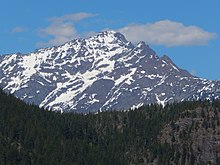Jack Mountain
| Jack Mountain | ||
|---|---|---|
|
Nohokomeen Glacier on the northwest flank (1966) |
||
| height | 2766 m North American Vertical Date of 1988 | |
| location | Whatcom County , Washington , USA | |
| Mountains | Northern Cascade Range | |
| Notch height | 1284 m | |
| Coordinates | 48 ° 46 '22 " N , 120 ° 57' 22" W | |
|
|
||
| First ascent | 1904 by EC Barnard | |
| Normal way | Mountaineering over exposed cliffs - Difficulty level 4 ( YDS ) | |
The Jack Mountain is the siebzehnthöchste mountain in the US state of Washington . It is one of ten non-volcanic peaks over 9,000 ft (2,743 m). From the south end of Ross Lake it is just 3 mi (4.8 km) 7,450 ft (2,271 m) steep to the summit at 2,766 m . The Nohokomeen Glacier fills almost completely the cirque from the upper slopes of Jack Mountain.
history
Jack Mountain was first described by surveyor Henry Custer in 1859 and named after prospector Jack Rowley, who was active on Canyon Creek. The first documented ascent was made in 1904 by the topographer EC Barnard. By the 1980s, climbing routes were established on most of the ridges, glaciers, and guided tours, seven in all. Most are at Difficulty Level 4 ( YDS ) and some require real technical climbing. All of them are long routes with large differences in elevation, which means that most groups will take three to four days to climb.
geology
Rock types
The mountain consists mainly of metamorphic rock of the Hozameen group of volcanic or sedimented origin. Mostly green slate from the Jura to Permian dominates . Most of the surface material is badly eroded by water and glacial ice. The lower flanks of the mountain in Devils Creek Basin are comprised of Lower Cretaceous sedimentary rocks that are part of the Harts Pass Formation. The lower reaches of the mountain on the Ross Lake side are composed of many different types of rock including orthogneiss , ultramafic rock , low grade phyllite , tonalite , diorite and mica schist .
Disturbances and origin
The Jack Mountain area consists of a small and a few normal faults , none of which are showing seismic activity. Jack Mountain was formed when the Hozameen Group was pushed over the younger Harts Pass Formation to the east, most likely caused by the Ross Lake Fault to the west. The lower flanks of the mountain to the west were formed by the heterogeneous Plutonic Ruby Creek Belt.
Geographic objects
- Nohokomeen Glacier - fills the northwest side of the mountain
- Northeast Glacier - steep and very rugged small glacier
- East Glacier - small sack glacier on the east side
- Northwest Glacier - small hanging glacier west of the summit ridge
- Crater Creek - main drain on the south side
- Devils Creek - main drain on the north side
- Nohokomeen Falls - waterfall on May Creek after a steep wall
- Roland Creek - on the steep west side, tributaries with many waterfalls
Ascent routes
The difficulty levels mentioned below are specified according to different systems.
- Southeast Ridge - first ascent by John Anderson and Alan Kearney in August 1977; Grade III, class 5.6
- Southeast Route - Grade 4
- East Ridge - First ascent by Carl and Gordon Skoog on July 16, 1984. Grade II, Class 4
- Northeast Glacier - First ascent by Fred Beckey , Dallas Kloke and Reed Tindall on July 19, 1978
- North Ridge - First ascent by Joe Vance and Bill Weitkamp on August 1, 1971; Grade II, grade 4
- Southwest Ridge - Grade 4
- South Face (South Flank) - Grade 4
Individual evidence
- ^ The NGS Data Sheet (Jack) . NOAA . Retrieved June 19, 2018.
- ↑ Jeff Howbert: Washington 100 Highest Peaks . The Northwest Peakbaggers Asylum.
- ↑ a b Fred W. Beckey: Stevens Pass to Rainy Pass (= Cascade alpine guide: climbing and high routes), 2nd edition, Volume 2, The Mountaineers Books, 1995, ISBN 978-0-89886-423-6 , p 196-199.
- ^ A b Harry M. Majors: Exploring Washington . Van Winkle Publishing Co, 1975, ISBN 978-0-918664-00-6 , p. 29.
- ^ Washington Geologic Information Portal . State of Washington. Retrieved June 20, 2018.
- ↑ a b Fred W. Beckey: Climbing and High Routes (= Cascade Alpine Guide). Mountaineers Books, Seattle, WA 2008, pp. 202-205.
Web links
- Jack Mountain ( English ) In: Geographic Names Information System . United States Geological Survey .
- Jack Mountain, Washington . PeakBagger.com. Retrieved June 19, 2018.
- Jack Mountain . SummitPost.org. Retrieved June 20, 2018.
- Jack Mountain (map) TopoQuest.com.


